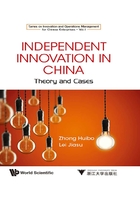
3.1 Case selection
3.1.1 Basic considerations and the principles of case selection
This chapter discusses the efficient path towards independent innovation in China and begins with case analysis. Given the diversity of enterprises, this chapter will consider 8 factors to select cases: The difference in the nature of the enterprise, the innovation model, innovation paradigm, the innovator's background, the nature of the industry, the process of innovation, the nature of the product, and the results of innovation (shown in Table 3-1).
Table 3-1 Basic considerations of case selection

Based on the above considerations, the case selection in this chapter follows these principles:
First, the case of the innovation model with typical characteristics will be selected. We try to choose some cases that are representative of some aspects. An example is Hisense, which is a state-owned enterprise in a traditional industry. Its innovation model is integrated innovation, and the innovation paradigm is regular innovation of mature enterprises; Xunlei, Tencent, and Chipscreen are private enterprises in emerging industries, whose model of innovation is independent development, and their innovation paradigm is unconventional innovation of pioneering enterprises; Chint is a private manufacturing enterprise in Wenzhou and it is an innovation model in itself. However, it is hard to regard one case as a category by a single standard, so the case can only be tentatively classified according to its typical characteristics.
Second, the enterprises in the Special Economic Zone (SEZ) of Shenzhen will be selected as the cases of regional industrial innovation. Shenzhen is at the forefront of the reform and opening up; after more than 30 years of reform and opening up, technological enterprises have mushroomed. Since the implementation of the independent innovation strategy, these enterprises have also taken the lead in staying ahead in independent innovation, and it is not hard to find that they have made achievements along diversified innovation paths regarding all of the characteristics of innovation. There are two types of independent innovation in Shenzhen. The first is the independent innovation model oriented towards the market from low-end product innovation to high-end product innovation. The representative enterprises of this type of innovation are Huawei, ZTE, BYD, Mindray, and CIMC. After transition and acceleration of this innovation model, these enterprises have steadily progressed along the road towards independent innovation. The second type is the emerging enterprises, like Xunlei, Tencent, Chipscreen, etc. These companies started relatively late, but directly from high-end R&D supported by venture investment. Therefore, the typical “knowledge and technology-oriented” independent innovation model formed. Therefore, Shenzhen as a model of regional independent innovation is very representative.
Third, some representative industries will be selected as industry analysis cases. The communications equipment manufacturing industry has developed rapidly in recent years. It is a typical independent innovation industry; it is necessary to study the typical cases in this industry. China still has some long-time backward industries, which have depended on the introduction of technology to survive over the past years; an example is the equipment manufacturing industry. In recent years, the equipment manufacturing industry has been developing rapidly, for example, Sany Heavy, Weichai Power, Foton Motor, and aviation products are very representative. At the same time, with the shortage of traditional energy, such as oil, coal, and natural gas, many countries have focused their attention on the development of renewable energy like wind, water, and solar energy. Although China started late in this area, there are some companies which depend on independent innovation to rank at the top in the world in recent years, so an analysis of the innovation carried out by these enterprises also has significance.
Fourth, the enterprises with the characteristics of regional development will be selected as typical enterprise cases. At present, except Shenzhen, the cities of regional development with typical significance are Wenzhou and Suzhou. The former model lacks innovation and was based on imitation, but Chint has stepped into the international market through “introduction, imitation, and re-innovation.” The early Suzhou model did not have much technical innovation, but there has been plenty of innovation in the field of emerging industry in recent years, such as Suntech Power, which has become an internationally famous enterprise in this field thanks to its independent innovation. Similar enterprises also have important research value.
In view of the above considerations, the case enterprises are mainly distributed in Shenzhen (7), Beijing and Tianjin (4), Shandong (3), Jiangsu and Zhejiang (3), Anhui and Hubei, etc., the numbers in brackets represent the number of cases selected.
3.1.2 Brief information concerning the case enterprises and the case list
The cases under analysis in this chapter are shown in Table 3-2.
Table 3-2 Enterprise cases
